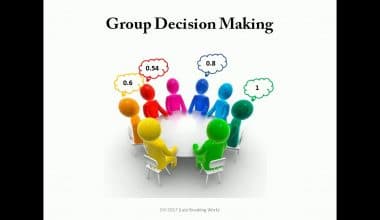To remain ahead of competition, companies often need to do the right things. In terms of execution, this entails keeping operations in order as well as identifying a viable approach. Many businesses, however, miss out on market opportunities because they neglect financial risks. Although operational risks pose a challenge, strategic risks are often underestimated, despite the fact that they can have a greater effect. This is why strategic risk management plans are pretty important.
In this post, we will identify strategic risk, discuss strategic risk management, and provide five implementation success tips.
What is Strategic Risk?
Strategic risk, in its most basic form, is the risk associated with poor business decisions. These types of risks have an effect on overall business strategies, but they are also required to reap the benefits. A bank, for example, takes on financial risk by providing credit, but it is an implicit risk that is directly linked to the bank’s business goals. However, since strategic risk is all about “doing the right things,” it may be more difficult to detect than operational threats, which are more about “doing things right.”
For the most part, strategic risks arise when companies struggle to meet the needs of the consumer. Basically, companies face risks and setbacks in order to accomplish their objectives. All internal options carry the risk of making the incorrect decision. To make matters even more complicated, competitive risks are not solely dependent on arbitrary judgments. External factors, on the other hand, such as consumer demand may also contribute to this.
What exactly is Strategic Risk Management (SRM)?
It pays to handle strategic risk once you recognize and understand that it is inherent in the market.
Strategic risk management is the method of assessing risks, analyzing their possible consequences, and taking the appropriate steps to minimize them. These internal and external threats jeopardize the company’s plan and objectives. For example, if a finance company signs a large new client, there is an inherent risk that the company may not be able to expand fast enough to offer the full service that the client requires. What if the client leaves after a short time as a result?
However, the finance company is aware of this risk and may plan to reduce it through recruiting part-time employees or retaining current staff, and freeing up their time by driving more efficiencies, such as by automation software.
Strategic risk management, as a focal point of enterprise risk management (ERM), focuses on the types of risks that can impact stakeholder value. As a result, executive-level leadership must devote time to managing and confronting this danger.
Here are some examples of strategic risk:
- Technological advancements
- Turnover in senior management
- Integration of mergers
- Pressure from stakeholders
- Pressure from competitors
- Changes in consumer demand
- Consumer tastes change.
- Regulatory alterations
It is important to evaluate the effects of strategic risks in order to prioritize the strategy for managing them. The two most important indicators for assessing competitive risks are:
Economic capital: the amount of equity needed to cover unanticipated losses. It is calculated using the company’s target debt ranking.
Risk-Adjusted Return On Capital (RAROC): RAROC aids in understanding the return on investment in relation to the risk involved. It establishes the level of return in relation to the risk taken. The formula is as follows: revenue minus expenditures minus projected loss + income from capital / capital
Process of Strategic Risk Management
Putting strategic risk management into effect entails a number of moves, plans and 2. It starts with an assessment of the various forms of competitive risk that can impact your organization.
#1. Understanding organizational strategy:
In order to assess the possible implications of strategic risk, you must first fully comprehend the organization’s strategy and objectives. This allows you to prioritize possible risks.
#2. Collect strategic risk data:
By interviewing executives and stakeholders, you can learn about how people in the organization perceive strategic risk. Data collection can be done by both internal and external staff who are affected by the risk. The use of automation tools and risk management software will also be extremely successful in gathering data and assisting in the assessment of risks that may impact your organization. It allows businesses to gain more consistency across the board, map out processes, and set real-time warnings, eliminating bottlenecks, data failures, vital man dependence, and increasing enforcement.
#3. Prepare a strategic risk profile for the organization:
Using the details from steps 1 and 2, build a strategic risk profile for the organization. It can be shown as a list or even a heat map to show what the top strategic threats are and how serious they are in terms of possible negative consequences.
But before developing a strategic risk management action plan, ensure that key executives and directors agree on the risk profile.
#4. Create an action plan:
The main aim of this whole phase is to create an action plan. This move will detail how the organization intends to deal with, reduce, ignore, or resolve strategic risks. It also entails defining strategies for managing strategic risks.
#5. Communicate and execute the strategy:
Once you’ve developed a strategic risk management plan, you must disseminate the message within the organization. Defining the organization’s risk culture encourages staff and team members to behave accordingly.
Strategic Risk Management Integration
Because strategic risk is linked to an organization’s strategies, strategic risk management must be integrated into the core processes of the organization.
Follow these six measures to combine risk management with strategic planning to embed strategic risk management into the inner workings of the organization:
- Create the strategy: Define your mission and vision, as well as the methods you would use to determine risks.
- Communication: Make it a point to explain to stakeholders and the internal team why strategic risk management is in everyone’s best interests. You should agree to daily reports and conversations about the process’s progress or gaps.
- Align the organization: Examine current processes and procedures to ensure risk management is incorporated and addressed. Provide updates if anything is out of date or missing information.
- Plan operations: Train everyone to understand how they can adopt best practices to prevent or track competitive risks.
- Monitor: Be sure to keep an eye on how processes are running and how business goals are being affected. Analysing data and monitoring KPIs is crucial to ensuring that you are “doing the right things” to achieve business goals. Furthermore, one of the best ways to control KPIs in real-time is to utilize an automation tool so you can continuously track KPIs through dashboards.
- Test and adapt: After implementation, keep an eye on the system. Perform quality reviews and don’t be afraid to make improvements if appropriate.
5 Tips for Success: Measuring and Managing Risk
Here are the top 5 tips for assessing and managing strategic risk in any market.
- Define business goals: When identifying business goals, many businesses struggle to incorporate or consider risk. It is critical at this point to outline the types of risks that can endanger your organization. This can be accomplished by a basic exercise such as SWOT analysis.
- Establish key performance indicators (KPIs): Key performance indicators (KPIs) are a way to assess your success and failures. So, determine what you want to calculate and track, such as revenue per customer. You can use automation tools to get dashboards and real-time feedback on these numbers so you can see how your processes are working in your favor.
- Identify Risks: Risks are unanticipated circumstances that can have an effect on the variability of your KPIs and results. Make a list of such threats so that when your company is in trouble, you can easily grasp what’s going on and work to fix the problem.
- Define risk tolerance levels: Main risk measures, or KRIs, predict risks in advance. If you define your risk tolerance thresholds, you can rely on an automated tool to notify you or handle the situation automatically once the threshold is reached.
- Provide reporting and monitoring: In order to keep track of how the organization is performing, you can continue to control threats and handle problems when they occur.
How Automation Would Help
You may use automation software to assist in assessing and monitoring competitive risks. Basically, all this would require is entering thresholds and requirements into your automation tool once you’ve established your strategic risk management strategy. This way, you can rely on the tool to notify you if anything goes wrong. You can monitor the company’s success and ensure that it is on track to meet its objectives by employing quantitative analysis.
You may also use research and analysis to test business decisions and their possible consequences before putting them into action. Data analytics will provide you with the knowledge you need to make the best decisions, or do the right things for your company. Automation tools have a number of advantages, including:
- Gives the team more time to concentrate on high-value projects.
- Eliminating Low-level manual tasks
- Reduces human errors to increase knowledge and documentation accuracy
- Improves enforcement by including audit trails and reports
- Provides real-time reporting for real-time perspectives and analysis
- Helps to map out processes in order to increase standardization and accuracy.
- Provides trend analysis and data analytics for better decision-making and more detailed insights.
- Sends and configures real-time updates and reminders.
The Approach of a CFO to Strategic Risk Management
A CFO is critical in his approach to strategic risk management. Basically, strategic risks have an effect on business strategies, so it is up to the CFO to assist in identifying, assessing, and mitigating those risks. If you are a CFO, you can help by:
- Stress testing: What effect will risks have on the business plan? If you’ve determined the response, you should integrate stress testing into the financial planning process.
- Risk analytics: Before going ahead with any strategy or investment, a CFO can conduct due diligence and use data automation tools to perform risk analytics to determine possible financial outcomes. Furthermore, via predictive analytics, you can use historical data to better forecast the future with risk analytics.
- Risk preferences: Risks are needed to usher in rewards. However, it is up to the executive leadership to determine how much risk is acceptable in order to proceed.
What Are the Risk Management Strategies?
What are the most important techniques for avoiding risk?
- Retention.
- Spreading.
- Preventing and cutting down on losses.
- Transfer (through Insurance and Contracts)
What Is the Importance of Strategic Risk Management?
Strategic risk management allows any company’s senior management to think about the future rather than just the day-to-day operations. Without this strategy, a business will simply make decisions to solve the problems and difficulties at hand, without taking the big picture into account.
What Are the Three Steps in the Strategic Risk Management Process?
Risk management is divided into three (3) stages:
- risk identification.
- risk assessment.
- risk control.
What Are the 7 Principles of Risk Management?
All businesses and organizations handle risk in their own ways.
- Make sure risks are detected early on….
- Consider the organization’s goals and objectives….
- Manage risk in relation to the situation.
- Involve stakeholders. …
- Ensure responsibilities and roles are clear. …
- Set up a regular review of risks.
- Try to get better all the time.
What Are Examples of Strategic Risks?
Examples of strategic risks
- Getting new products or services out into the market.
- Mergers and acquisitions that don’t work out.
- Changes in the market or industry, like a change in what customers want or need, can happen.
- Issues with suppliers and other parties involved
In conclusion
Businesses face their most important upsides and downsides when it comes to competitive threats. Strategic risk management must be implemented in order for the organization to be properly positioned to handle strategic risks. An automation tool can assist you in better managing all types of threats, including strategic risks.
- Risk Management Strategies: 5+ Strategies You Can Follow Now!!!
- Risk Management Plan: 5 Simple Steps & All You Need
- Business Strategy: Levels of Business Strategy+10 Best Business Strategy Examples
- Strategic Goals: Setting Goals For any Business(+ Detailed Guide).
- What Is Strategic Financial Management?- Functions and Importance






